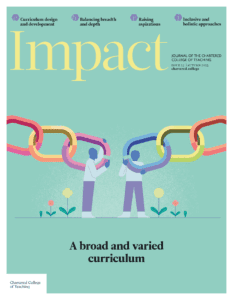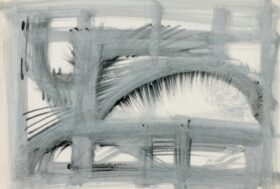Making expertise visible: Using semantic waves to strengthen curriculum and lesson design
Written by: Bethany Howes

8 min read
BETHANY HOWES (NÉE TAYLOR), SUBJECT DEVELOPMENT LEAD (SCIENCE), TEACH FIRST, UK
Look at the conversation in Figure 1. Who is the expert and who is the novice? How can we tell and how can novices develop expertise? These questions shaped my master’s research and continue to inform my work as a teacher, curriculum leader and teacher educator. This perspective article summarises insights from my dissertation and explores how they have influenced my practice and approach to lesson and curriculum design, offering ideas for fellow educators to consider in their own planning.
Figure 1: A conversation between two people about cilia
Novice versus expert: What is the difference?
Research reveals that novices and experts think in qualitatively different ways. Experts possess vast, interconnected knowledge bases, enabling them to recognise patterns, solve problems and apply knowledge flexibly (Kalyuga et al., 2003; Persky and Robinson, 2017). Novices, by contrast, rely on isolated fact
Join us or sign in now to view the rest of this page
You're viewing this site as a guest, which only allows you to view a limited amount of content.
To view this page and get access to all our resources, join the Chartered College of Teaching (it's free for trainee teachers and half price for ECTs) or log in if you're already a member.
- Brooke M (2019) Guiding teacher talk in the content and language integrated learning classroom using semantics from Legitimation Code Theory. Teaching in Higher Education 25(7): 812–824.
- Gibbons J (2018) Exploring conceptual legal knowledge building in law students’ reflective reports using theoretical constructs from the sociology of education: What, how and why? The Law Teacher 52(1): 38–52.
- Hassan SL (2017) Tutors’ role in tutorials: ‘unpacking’ and ‘repacking’ during the semantic journey. South African Journal of Higher Education 31(3): 99–115.
- Jackson F (2016) Unraveling high school English literature pedagogic practices: A Legitimation Code Theory analysis. Language and Education 30(6): 536–553.
- Kalyuga S, Ayres P, Chandler P et al. (2003) The expertise reversal effect. Educational Psychologist 38(1): 23–31.
- Macnaught L, Maton K, Martin JR et al. (2013) Jointly constructing semantic waves: Implications for teacher training. Linguistics and Education 24(1): 50–63.
- Mouton M and Archer E (2019) Legitimation code theory to facilitate transition from high school to first-year biology. Journal of Biological Education 53(1): 2–20.
- Maton K (2013) Making semantic waves: A key to cumulative knowledge-building. Linguistics and Education 24(1): 8–22.
- Maton K (2015) Legitimation Code Theory: Building knowledge about knowledge-building. In: Maton K, Hood S and Suellen S (eds) Knowledge-Building: Educational Studies in Legitimation Code Theory. New York: Routledge, pp. 1–23.
- Mccrea P (2025) Expert-induced blindness: How we overestimate student knowledge. Evidence Snacks. Available at: https://snacks.pepsmccrea.com/p/expert-induced-blindness (accessed 23 April 2025).
- Ofqual (2017) GCSE, AS and A level assessment objectives. Available at: www.gov.uk/government/publications/assessment-objectives-ancient-languages-geography-and-mfl/gcse-as-and-a-level-assessment-objectives#science (accessed 7 October 2025).
- Persky AM and Robinson JD (2017) Moving from novice to expertise and its implications for instruction. American Journal of Pharmaceutical Education 81(9): 6065.
5
2
votes
Please Rate this content
Please login to comment
0 Comments
Oldest
Newest
Most Voted
Inline Feedbacks
View all comments










